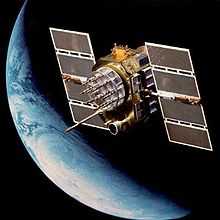OPS 5112
| Mission type |
Navigation Technology |
|---|---|
| Operator | US Air Force |
| COSPAR ID | 1978-047A[1] |
| SATCAT № | 10893[1] |
| Mission duration |
5 years (planned) 9 1⁄2 years (achieved) |
| Spacecraft properties | |
| Spacecraft type | GPS Block I |
| Manufacturer | Rockwell[2] |
| Launch mass | 759 kilograms (1,673 lb)[2] |
| Start of mission | |
| Launch date | 13 May 1978, 10:34 UTC |
| Rocket | Atlas E/F SGS-1, 49F[3] |
| Launch site | Vandenberg SLC-3E[3] |
| End of mission | |
| Deactivated | February 1988 |
| Orbital parameters | |
| Reference system | Geocentric |
| Regime |
Medium Earth (Semi-synchronous) |
| Perigee | 20,056 kilometres (12,462 mi)[4] |
| Apogee | 20,195 kilometres (12,549 mi)[4] |
| Inclination | 63.1 degrees[4] |
| Period | 715.67 minutes[4] |
OPS 5112, also known as Navstar 2, NDS-2, GPS I-2 and GPS SVN-2, was an American navigation satellite launched in 1978 as part of the Global Positioning System development programme. It was the second of eleven Block I GPS satellites to be launched.[2]
OPS 5112 was launched at 10:34 UTC on 13 May 1978, atop an Atlas E/F carrier rocket with an SGS-1 upper stage. The Atlas used had the serial number 49F, and was originally built as an Atlas F.[3] The launch took place from Space Launch Complex 3E at Vandenberg Air Force Base,[5] and placed OPS 5112 into a transfer orbit. The satellite raised itself into medium Earth orbit using a Star-27 apogee motor.[2]
By 20 June 1978, OPS 5112 was in an orbit with a perigee of 20,056 kilometres (12,462 mi), an apogee of 20,195 kilometres (12,549 mi), a period of 715.67 minutes, and 63.1 degrees of inclination to the equator.[4] The satellite had a design life of 5 years and a mass of 758 kilograms (1,671 lb).[2] It broadcast the PRN 07 signal in the GPS demonstration constellation, and was retired from service in early-mid February 1988.
References
- ↑ 1.0 1.1 "Navstar 2". US National Space Science Data Center. Retrieved 25 June 2012.
- ↑ 2.0 2.1 2.2 2.3 2.4 Krebs, Gunter. "GPS (Navstar)". Gunter's Space Page. Retrieved 12 July 2012.
- ↑ 3.0 3.1 3.2 McDowell, Jonathan. "Launch Log". Jonathan's Space Page. Retrieved 12 July 2012.
- ↑ 4.0 4.1 4.2 4.3 4.4 McDowell, Jonathan. "Satellite Catalog". Jonathan's Space Page. Retrieved 12 July 2012.
- ↑ McDowell, Jonathan. "Launch List". Launch Vehicle Database. Jonathan's Space Page. Retrieved 12 July 2012.
| |||||||||||||||||||||||||||||
| ||||||||
